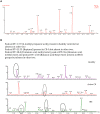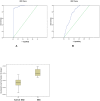An investigation of fecal volatile organic metabolites in irritable bowel syndrome
- PMID: 23516449
- PMCID: PMC3596408
- DOI: 10.1371/journal.pone.0058204
An investigation of fecal volatile organic metabolites in irritable bowel syndrome
Abstract
Diagnosing irritable bowel syndrome (IBS) can be a challenge; many clinicians resort to invasive investigations in order to rule out other diseases and reassure their patients. Volatile organic metabolites (VOMs) are emitted from feces; understanding changes in the patterns of these VOMs could aid our understanding of the etiology of the disease and the development of biomarkers, which can assist in the diagnosis of IBS. We report the first comprehensive study of the fecal VOMs patterns in patients with diarrhea-predominant IBS (IBS-D), active Crohn's disease (CD), ulcerative colitis (UC) and healthy controls. 30 patients with IBS-D, 62 with CD, 48 with UC and 109 healthy controls were studied. Diagnosis of IBS-D was made using the Manning criteria and all patients with CD and UC met endoscopic, histologic and/or radiologic criteria. Fecal VOMs were extracted by solid phase microextraction (SPME) and analyzed by gas chromatography-mass spectrometry (GC-MS). 240 VOMs were identified. Univariate analysis showed that esters of short chain fatty acids, cyclohexanecarboxylic acid and its ester derivatives were associated with IBS-D (p<0.05), while aldehydes were more abundant in IBD (p<0.05). A predictive model, developed by multivariate analysis, separated IBS-D from active CD, UC and healthy controls with a sensitivity of 94%, 96% and 90%; and a specificity of 82%, 80% and 80% respectively (p<0.05). The understanding of the derivation of these VOMs may cast light on the etiology of IBS-D and IBD. These data show that fecal VOMs analyses could contribute to the diagnosis of IBS-D, for which there is no laboratory test, as well as IBD.
Conflict of interest statement
Figures




References
-
- Sandler RS (1990) Epidemiology of irritable bowel syndrome in the United States. Gastroenterology 99: 409–15. - PubMed
-
- Azpiroz F, Bouin M, Camilleri M, Mayer EA, Poitras P, et al. (2007) Mechanisms of hypersensitivity in IBS and functional disorders. Neurogastroenterol Motill 19: 62–88. - PubMed
-
- Grundy D, Al-Chaer ED, Aziz Q, Collins SM, Meiyun KE, et al. (2006) Fundamentals of Neurogastroenterology: Basic Science. Gastroenterology 130(5): 1391–1411. - PubMed
Publication types
MeSH terms
Substances
LinkOut - more resources
Full Text Sources
Other Literature Sources
Medical
Miscellaneous

